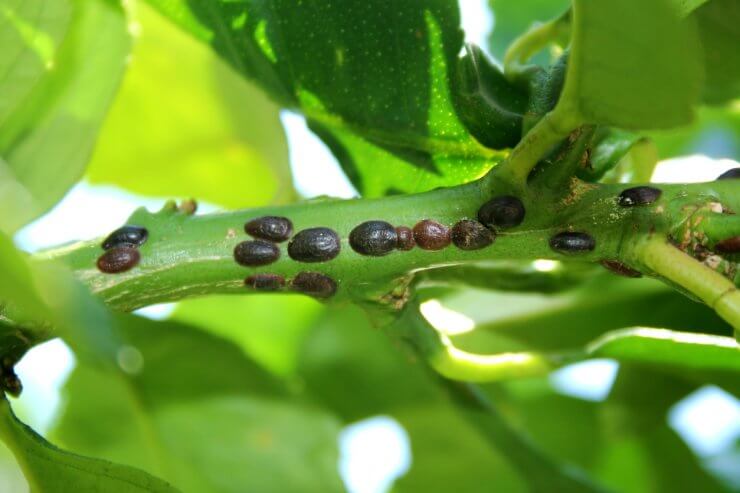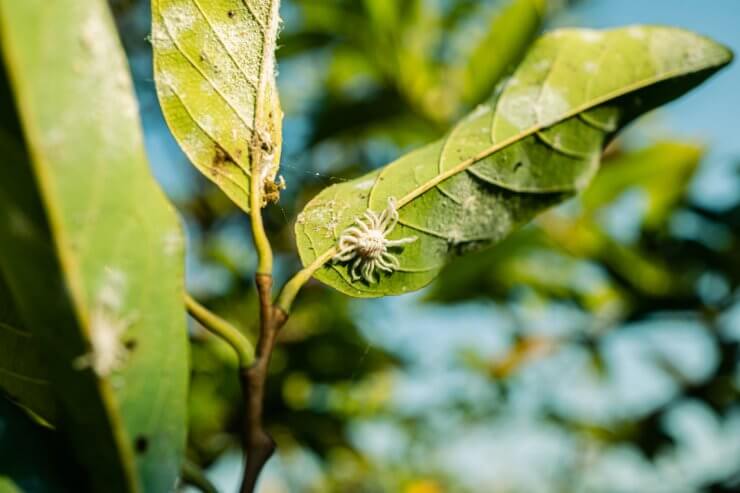
Citrus scale on lemon tree
Pests on your lemon trees, left unchecked, can damage and destroy your lovely trees. Keeping a close watch on your trees during regular daily inspections will help you spot any pests before they can do irreparable harm. Healthy lemon trees can bounce back from pest damage if you catch the pests quickly.
Spot the Symptoms of Lemon Tree Pests
Check leaves, branches, and fruit for these symptoms that come from pests on the prowl.
| Symptom | Pest |
| Whitish coating on underside of leaves or on branches; sometimes looks like blisters | Armored scale, spider mites, ants (harvesting honeydew from scale) |
| Winding trail scars on the leaves | Leaf miners |
| Yellowing leaves; clusters of small “bumps” on underside of leaves | Aphids |
| Tiny waxy-looking clusters | Mealybugs, whitefly eggs and larvae |
| Webs between trunk and branches | Spider mites |
| Honeydew on leaves | Spider mites, scale |
| Chewed leaf edges | Orangedog caterpillars |
| Symptom | Pest |
| Deformed fruit | Citrus thrips, snails |
How to Treat Pests on Lemon Trees
Here are some proven ways to get rid of pests on your lemon trees. Choose the best treatment for the type of pests invading your trees.
- Pick off the pests. Use your garden gloves to remove the pests by hand. After removal, destroy pests by drowning them in a bucket of soapy water or crushing them with your foot. Handpicking isn’t efficient or practical for very small pests, but works well with larger pests.
- Remove overripe or deformed fruit. For the most part, lemons stay fresh on the tree until you pick them. But if you notice any deformed fruit or fruit that look like it’s rotting on the tree, remove it as soon as possible. Rotting fruit can attract pests that further damage your tree or cause disease.
- Apply insecticidal soap. Insecticidal soap is organic. The potassium salts in insecticidal soap help remove an insect’s protective waxes, causing destruction of insect membranes and killing them. Mix the soap with water to create your solution, and apply directly to insects on any plants. While insecticidal soap is less apt to affect other organisms, certain plants might be sensitive to the soap and can suffer leaf burn.
- Apply horticultural oils. Combine plant- or petroleum-based oils with water to produce horticultural sprays. Neem oil, for instance, is derived from seed extracts of the neem plant. Oil-based sprays block an insect’s air holes, interfere with an insect’s metabolism, disrupt insect feeding, and inhibit insect growth. Like insecticidal soaps, horticultural oils can cause plant injury if not properly diluted.

Mealybugs on a lemon tree
- Make your own pest spray. You can make your own pest spray with benign materials. Mix 1 tablespoon of baking soda, 1/2 teaspoon of a mild dish detergent, and 2 1/2 tablespoons of olive oil in a gallon of water to make a solution that will repel all kinds of bugs, as well as a fungicide for blight and mildew on lemon plant leaves. Shake it well in your bottle before spraying and repeat every week for it to be continuously effective.
- Create a pest barrier. One way to deter those small but mighty pests intent on sucking the life out of your tree’s leaves is to create a physical barrier between the ground and the foliage. It’s easy enough to do: take a wide piece of masking tape or tangle guard just long enough to wrap around a section of the tree trunk. If you have a support stick, wrap a section of that at the same height as you did on the tree. Once you’ve wrapped the tree trunk and its support, add Tanglefoot to the tape. The tape does just as its name describes—it snags whatever walks over it. Since your tree is an appealing food source to many pests—including ants—this barrier will deter them. But still, be sure to inspect the tape daily: wind can carry spider mites to your plants, and if too many insects get caught on the Tanglefoot, others will just use them as a bridge to keep climbing. There’s another product called Bug Band that you wrap around your tree’s trunk. It works in much the same way as Tanglefoot does—by snagging insects on its sticky surface. Check your tree daily to see if you’ve caught anything. Make it a habit to inspect your tree after you water it to check for infestation. And don’t put your tree near a wall, railing, or other plants; they’ll just serve as bridges for pests.
- If your tree is infested, act quickly. If you discover that your lemon tree is infested with anything, you need to wash it down immediately—with soap and water. Dawn dishwashing liquid—long heralded as the miracle treatment for waterfowl caught in oil spills—can help you eradicate an infestation on your lemon tree. Scrub your tree with a washcloth, with warm soapy water, from top to bottom. Make sure you wash both sides of the leaves and scrub off anything that doesn’t belong there; mold can form in the wake of insect infestations. Any spot that’s too narrow for your washcloth to reach—use a toothbrush, especially at the Y sections of branches. Make sure you get every single insect off your tree, then treat it thoroughly with a horticultural oil or neem oil.
Do pests attack your lemon trees every year? How do you handle removing them—and even preventing them in the first place? Please tell us how you treat your lemon trees to avoid pests.


 Previous
Previous

